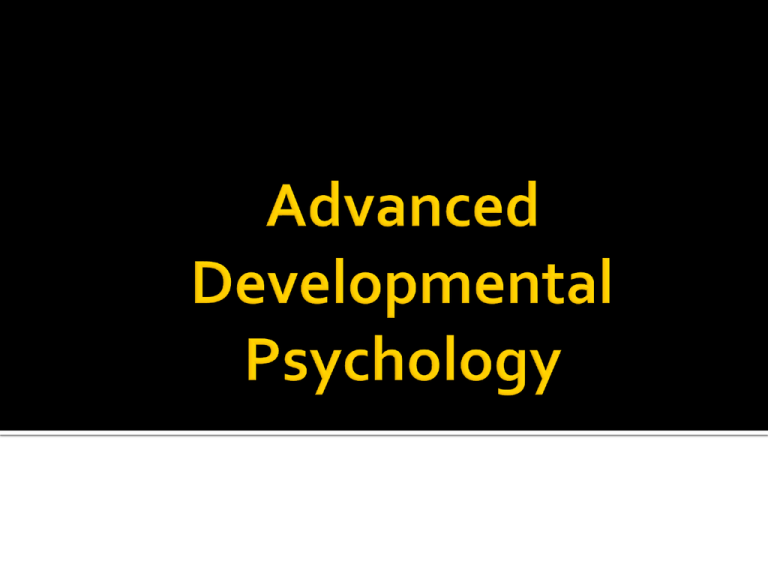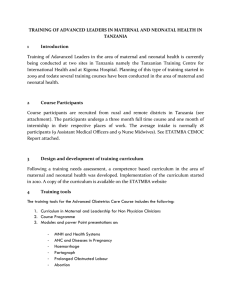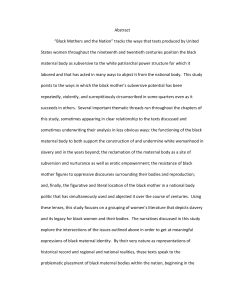ppt19
advertisement

PSY 620P MacKenzie, M. J., Nicklas, E., Waldfogel, J., & Brooks-Gunn, J. (2013). Spanking and Child Development Across the First Decade of Life. Pediatrics. doi: 10.1542/peds.2013-1227 Kelly Shaffer Spanking: Potentially deleterious to children American Academy of Pediatrics recommends against use Gershoff 2002: Meta-analysis of 88 studies shows spanking related to: Moral internalization Aggression in childhood and adulthood Delinquent/antisocial behavior in childhood (not adulthood) Poor parent-child relationship quality Poor mental health in childhood and adulthood Likelihood of being victim of physical abuse Adult abuse of own child or spouse Shaffer | MacKenzie et al., 2013 1. 2. 3. 4. Few longitudinal studies Missing measures of stress & SES No study of paternal spanking Little study of effects of spanking on children’s cognitive development Shaffer | MacKenzie et al., 2013 Fragile Families and Child Well-Being Study 1933 families for externalizing behavior analyses 1532 families for receptive vocabulary analyses Included families: may have more resources and/or be more stable at baseline than excluded families Shaffer | MacKenzie et al., 2013 Maternal & Paternal Spanking “In the past month, have you spanked (child) because (she/he) was misbehaving or acting up?” 0 times <1 time/week >2 times/week No spanking Low Frequency Spanking High Frequency Spanking Shaffer | MacKenzie et al., 2013 Child Externalizing Behavior Age 9: Aggression & Rule-Breaking subscales of CBCL Age 3: Aggression & Destructive subscales of CBCL (ctrl) Child Receptive Vocabulary Age 9: Peabody Picture Vocabulary Test (PPVT) Age 3: PPVT (ctrl) Shaffer | MacKenzie et al., 2013 Category Variable Child Risk Factors Gender; age; low birth weight; if first born; infant temperament Maternal and Family Characteristics Maternal age; marital structure; mother’s race/ethnicity; maternal education; household income; mother foreign-born; mother’s residence at age 15; maternal employment, number of adults and children in home Prenatal Risks Late onset of prenatal care; risky health behavior; IPV; birth father’s supportiveness Maternal Risk Factors Mother’s parenting stress; mother depression or GAD dx; mother’s impulsivity; mother’s cognitive level; mother’s frequency of cognitively stimulating activities with child Rumper | MacKenzie et al., 2013 Age 3 Age 5 5% 13% 43% Mothers 48% 47% 44% Spanking child ≥2/week Spanking child <2/week No Spanking 3% 7% Fathers 60% Shaffer | MacKenzie et al., 2013 30% 33% 67% Shaffer | MacKenzie et al., 2013 Shaffer | MacKenzie et al., 2013 Maternal spanking at age 5 predicts children’s externalizing behavior at age 9 Extensive control variables increases confidence in effect High-frequency paternal spanking at age 5 affects children’s verbal capacity at age 9 Effects hold across genders and race/ethnicity Rumper| MacKenzie et al., 2013 Q) Are there any other variables that should have been included in this analysis? Q) How do these results hold in comparison to the Lansford et al. article? Q)How might this study appear in a different population (e.g. middle or high SES)? Rumper | MacKenzie et al., 2013 (Ispa et al., 2004) Rubenstein How do parenting practices, particularly those engaged in by the mother, affect the nature of the parent-child relationship? Maternal control and maternal warmth are central to parenting Maternal Intrusiveness • A constellation of insensitive, interfering parenting behaviors • Dominates a child’s play agenda so that the child has little or no influence on its content or pace Maternal Warmth • A mother’s physical and verbal expressions of love, attentiveness, and respect or admiration for the child Rubenstein Mixed findings for maternal intrusiveness and mother-child relationship outcomes European American Negative non-European American Neutral Positive Maternal intrusiveness: same or different meaning across cultures? Rubenstein Examine the extent to which maternal intrusiveness during play at 15 months affects child negativity, child engagement, and dyadic mutuality at 25 months. Does maternal warmth moderate the link between maternal intrusiveness and later quality of mother-child relationship? Do these relationships differ across ethnic groups? • European American, African American, Mexican American (less acculturated), and Mexican American (more acculturated) Rubenstein Mother-infant pairs: European American (n = 579), African American (n = 412), less acculturated Mexican American (n = 131), more acculturated Mexican American (n=110) 10-min parent-child play sessions (15 months, 25 months) 15 months 25 months Maternal intrusiveness ✔ Maternal warmth ✔ Child negativity ✔ ✔ Child engagement ✔ ✔ Dyadic mutuality ✔ ✔ Rubenstein Maternal Intrusiveness predicted child negativity in all ethnic groups. European American intrusiveness negative changes in child engagement intrusiveness decreases in dyadic mutuality African American intrusiveness child negativity [only if low maternal warmth] More acculturated Mexican American intrusiveness decreases in dyadic mutuality Rubenstein Maternal intrusiveness predicted negative changes in two of the three relationship outcomes (negativity and engagement) 10months-later. The intrusiveness-negative outcomes link was moderated by ethnicity and, for African Americans, by warmth. Rubenstein Disorganized at elevated risk, weaker effects for avoidance & resistance ▪ Meta-analysis, 69 samples (5,947). ▪ overall d = 0.31 (95% CI: 0.23, 0.40) Larger effects for boys, clinical samples, observation-based outcome assessments, attachment assessments other than the Strange Situation. ▪ Fearon, R. P., M. J. Bakermans-Kranenburg, et al. (2010). "The significance of insecure attachment and disorganization in the development of children s externalizing behavior: A meta-analytic study." Child Development 81(2): 435-456. Messinger 33 Disorganized externalizing Based on 42 independent samples (N = 4,614), Messinger (Groh, Roisman, van Ijzendoorn, BakermansKranenburg, & Fearon, 2012) 34 15 month visit Strange Situation 6.5 year visit Teacher report of Problem Behavior using the Child Symptom Inventory-4 8 year visit Parent report of Problem Behavior using the Child Symptom Inventory-4 Child report of Problem Behaviors using the Dominic-R Messinger 42 Disorganized attachment with dad at 15 months predicts children’s higher externalizing behavior problems Child’s resistance with mother and father predicted higher teacher-rated externalizing behavior problems. Even when children showed high resistance with their father, if the child demonstrated low resistance with mom it served as a protective factor Low resistance with dad also predicted lower teacher reported behavior problems despite level of resistance with mom Are the effects of early relationship experiences on adaptation enduring or merely transient? Two competing theoretical models 1. Enduring Effects 2. Revisionist Difference: patterns of association ▪ Stable across time ▪ Increasingly smaller association Enduring Effects Model Early relationship experiences organize early developmental adaptation and continue to shape adjustment across development Revisionist Model Early relationship experiences directly effect early childhood development but then only indirectly effect subsequent adaptation Minnesota Longitudinal Study of Risk and Adaptation (MLSRA) N = 243 45% female, 65% White/Non-Hispanic Maternal sensitivity Feeding observations (3 + 6 mo.) Play interactions (6 mo.) Problem-solving and Teaching tasks (24 + 42 mo.) Social Competence Teacher-rated competence with peers during ▪ ▪ ▪ ▪ Kindergarten Grades 1-3 Grade 6 Age 16 Academic Competence Peabody Individual Achievement Test ▪ Grades 1-3 and 6 Woodcock-Johnson Tests of Achievement ▪ Age 16 Maternal Sensitivity 0 Social and Time 1 Academic Competence at Different Times 0 Time 2 0 0 Time 3 0 Time 4 Time 5 Time 6 Social competence: ΔΧ2 = 17.18, p <.001 Maternal Sensitivity Academic Competence: ΔΧ2 = 15.03, p <.001 Social and Time 1 Academic Competence at Different Times Time 2 Time 3 Time 4 Time 5 Time 6 Maternal Sensitivity 0 Social and Time 1 Academic Competence at Different Times 0 Time 2 0 0 Time 3 0 Time 4 Time 5 Time 6 Social competence: ΔΧ2 = 11.54, p <.001 Maternal Sensitivity Academic Competence: ΔΧ2 = 9.96, p =.002 Social and Time 1 Academic Competence at Different Times Time 2 Time 3 Time 4 Time 5 Time 6 Maternal Sensitivity 0 Social and Time 1 Academic Competence at Different Times Covariates 0 Time 2 0 0 Time 3 0 Time 4 Time 5 Time 6 Social competence: ΔΧ2 = 1.72, p = .19 Maternal Sensitivity Social and Time 1 Academic Competence at Different Times Covariates Time 2 Time 3 Time 4 Time 5 Time 6 Enduring effects of: Gender** Maternal Education** Socioeconomic Status Ethnicity Maternal Sensitivity Social and Time 1 Academic Competence at Different Times Covariates Academic Competence: ΔΧ2 = 9.96, p =.002 Time 2 Time 3 Time 4 Time 5 Time 6 Enduring effects of: Gender* Maternal Education* Socioeconomic Status* Ethnicity Maternal Sensitivity Social and Time 1 Academic Competence at Different Times Covariates Social Competence: ΔΧ2 = 0.82, p =.37 Time 2 Time 3 Time 4 Time 5 Time 6 Enduring effects of: Gender** Maternal Education** Socioeconomic Status Ethnicity Maternal Sensitivity Social and Time 1 Academic Competence at Different Times Covariates Academic Competence: ΔΧ2 = 3.96, p <.05 Time 2 Time 3 Time 4 Time 5 Time 6 Enduring effects of: Gender* Maternal Education* Socioeconomic Status Ethnicity The association between early maternal sensitivity and children’s social and academic competence is stable across time But this is not fully explained by stability (transactional model) Bi-directional relationship between functioning and environment Gender, maternal education, and socioeconomic status showed enduring associations with children’s competence Early maternal sensitivity continue to predict academic competence above these covariates Why the continued association with academic competence but not social competence (with the inclusion of covariates)?







